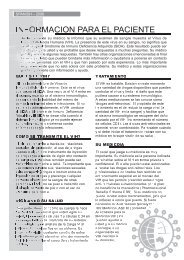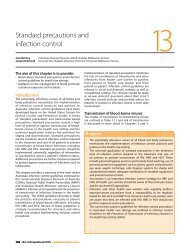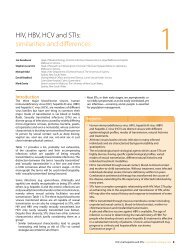B Positive – all you wanted to know about - ASHM
B Positive – all you wanted to know about - ASHM
B Positive – all you wanted to know about - ASHM
You also want an ePaper? Increase the reach of your titles
YUMPU automatically turns print PDFs into web optimized ePapers that Google loves.
CLINICAL ASSESSMENT OF<br />
PATIENTS WITH HEPATITIS B<br />
VIRUS INFECTION<br />
Darrell HG Crawford School of Medicine, University of Queensland, Greenslopes Private Hospital; Department of<br />
Gastroenterology and Hepa<strong>to</strong>logy, Princess Alexandra Hospital, Brisbane, QLD.<br />
Rebecca J Ryan School of Medicine, University of Queensland, Greenslopes Private Hospital; Department of<br />
Gastroenterology and Hepa<strong>to</strong>logy, Princess Alexandra Hospital, Brisbane, QLD.<br />
Nghi Phung Department of Addiction Medicine, Department of Gastroenterology and Hepa<strong>to</strong>logy,<br />
Westmead Hospital, Westmead, NSW.<br />
Links <strong>to</strong> : Chapter : Virology: viral replication and drug resistance<br />
Chapter 3: Hepatitis B virus testing and interpreting test results<br />
Chapter 4: Natural his<strong>to</strong>ry of chronic hepatitis B infection<br />
Chapter 7: Treatment of chronic hepatitis B virus infection<br />
Chapter 8: Managing patients with advanced liver disease<br />
Chapter 9: Hepatitis B virus-related hepa<strong>to</strong>cellular carcinoma<br />
Chapter 11: Infection control and occupational health<br />
KEY POINTS<br />
6<br />
� the assessment of a patient should be considered in the context of the natural his<strong>to</strong>ry of hepatitis<br />
b infection.<br />
� transmission risks, lifestyle modification, cultural fac<strong>to</strong>rs and long term complications associated<br />
with chronic hepatitis b infection are important elements for patient education.<br />
Introduction<br />
following acute hepatitis b virus (HbV)<br />
infection, 95% of adult patients will mount an<br />
immune response adequate <strong>to</strong> clear the virus.<br />
furthermore, only one third of adult patients<br />
experience symp<strong>to</strong>ms of acute hepatitis<br />
following exposure, while the remaining<br />
patients usu<strong>all</strong>y have subclinical disease. in<br />
contrast, 90% of infants born <strong>to</strong> Hbeag-positive<br />
mothers and 30% of infants exposed before five<br />
years of age will develop chronic HbV infection<br />
(cHb), but symp<strong>to</strong>matic acute infection occurs<br />
very infrequently in this age group. 1<br />
therefore, the majority of patients with HbV<br />
infection who are encountered in primary<br />
care will have cHb. such patients are usu<strong>all</strong>y<br />
asymp<strong>to</strong>matic until they develop features<br />
associated with hepatic decompensation. as<br />
a consequence of the silent clinical course<br />
of cHb, the management for the majority of<br />
affected patients is not centred upon symp<strong>to</strong>m<br />
relief but rather, care is primarily aimed at<br />
preventing disease progression <strong>to</strong> cirrhosis and<br />
hepa<strong>to</strong>cellular carcinoma (Hcc). 1-3<br />
Assessment of patients with<br />
chronic HBV infection<br />
His<strong>to</strong>ry and physical examination<br />
the assessment of patients with cHb should<br />
commence with a thorough clinical his<strong>to</strong>ry and<br />
physical examination. aspects of the clinical<br />
his<strong>to</strong>ry that deserve close attention are risk<br />
fac<strong>to</strong>rs for acquisition of cHb, such as ethnic<br />
background, a family his<strong>to</strong>ry of cHb, and a family<br />
his<strong>to</strong>ry of Hcc; and host or viral fac<strong>to</strong>rs that are<br />
associated with an increased risk of cirrhosis,<br />
including older age (related <strong>to</strong> a longer duration<br />
of infection), heavy alcohol consumption,<br />
cigarette smoking and co-infection with other<br />
viruses, e.g. hepatitis c virus (HcV), hepatitis<br />
b <strong>Positive</strong> <strong>–</strong> <strong>all</strong> <strong>you</strong> <strong>wanted</strong> <strong>to</strong> <strong>know</strong> <strong>about</strong> hepatitis b: a guide for primary care providers 51






